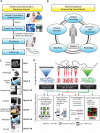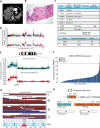Personalized oncology through integrative high-throughput sequencing: a pilot study
- PMID: 22133722
- PMCID: PMC3476478
- DOI: 10.1126/scitranslmed.3003161
Personalized oncology through integrative high-throughput sequencing: a pilot study
Abstract
Individual cancers harbor a set of genetic aberrations that can be informative for identifying rational therapies currently available or in clinical trials. We implemented a pilot study to explore the practical challenges of applying high-throughput sequencing in clinical oncology. We enrolled patients with advanced or refractory cancer who were eligible for clinical trials. For each patient, we performed whole-genome sequencing of the tumor, targeted whole-exome sequencing of tumor and normal DNA, and transcriptome sequencing (RNA-Seq) of the tumor to identify potentially informative mutations in a clinically relevant time frame of 3 to 4 weeks. With this approach, we detected several classes of cancer mutations including structural rearrangements, copy number alterations, point mutations, and gene expression alterations. A multidisciplinary Sequencing Tumor Board (STB) deliberated on the clinical interpretation of the sequencing results obtained. We tested our sequencing strategy on human prostate cancer xenografts. Next, we enrolled two patients into the clinical protocol and were able to review the results at our STB within 24 days of biopsy. The first patient had metastatic colorectal cancer in which we identified somatic point mutations in NRAS, TP53, AURKA, FAS, and MYH11, plus amplification and overexpression of cyclin-dependent kinase 8 (CDK8). The second patient had malignant melanoma, in which we identified a somatic point mutation in HRAS and a structural rearrangement affecting CDKN2C. The STB identified the CDK8 amplification and Ras mutation as providing a rationale for clinical trials with CDK inhibitors or MEK (mitogen-activated or extracellular signal-regulated protein kinase kinase) and PI3K (phosphatidylinositol 3-kinase) inhibitors, respectively. Integrative high-throughput sequencing of patients with advanced cancer generates a comprehensive, individual mutational landscape to facilitate biomarker-driven clinical trials in oncology.
Figures



Similar articles
-
Whole-Exome Sequencing of Metastatic Cancer and Biomarkers of Treatment Response.JAMA Oncol. 2015 Jul;1(4):466-74. doi: 10.1001/jamaoncol.2015.1313. JAMA Oncol. 2015. PMID: 26181256 Free PMC article.
-
Development and clinical application of an integrative genomic approach to personalized cancer therapy.Genome Med. 2016 Jun 1;8(1):62. doi: 10.1186/s13073-016-0313-0. Genome Med. 2016. PMID: 27245685 Free PMC article.
-
Clinical interpretation of whole-genome and whole-transcriptome sequencing for precision oncology.Semin Cancer Biol. 2022 Sep;84:23-31. doi: 10.1016/j.semcancer.2021.07.003. Epub 2021 Jul 10. Semin Cancer Biol. 2022. PMID: 34256129 Review.
-
A targeted next-generation sequencing assay detects a high frequency of therapeutically targetable alterations in primary and metastatic breast cancers: implications for clinical practice.Oncologist. 2014 May;19(5):453-8. doi: 10.1634/theoncologist.2013-0377. Epub 2014 Apr 7. Oncologist. 2014. PMID: 24710307 Free PMC article.
-
A 2015 update on predictive molecular pathology and its role in targeted cancer therapy: a review focussing on clinical relevance.Cancer Gene Ther. 2015 Sep;22(9):417-30. doi: 10.1038/cgt.2015.39. Epub 2015 Sep 11. Cancer Gene Ther. 2015. PMID: 26358176 Review.
Cited by
-
Integration of Germline Pharmacogenetics Into a Tumor Sequencing Program.JCO Precis Oncol. 2018;2:PO.18.00011. doi: 10.1200/po.18.00011. Epub 2018 Jul 23. JCO Precis Oncol. 2018. PMID: 32832831 Free PMC article.
-
Molecular prescreening to select patient population in early clinical trials.Nat Rev Clin Oncol. 2012 Apr 3;9(6):359-66. doi: 10.1038/nrclinonc.2012.48. Nat Rev Clin Oncol. 2012. PMID: 22473105 Review.
-
Oncologists' Use of Genomic Sequencing Data to Inform Clinical Management.JCO Precis Oncol. 2018 Feb 21;2:PO.17.00122. doi: 10.1200/PO.17.00122. eCollection 2018. JCO Precis Oncol. 2018. PMID: 32914003 Free PMC article.
-
Delivering on the promise of precision cancer medicine.Genome Med. 2016 Oct 25;8(1):110. doi: 10.1186/s13073-016-0373-1. Genome Med. 2016. PMID: 27782852 Free PMC article. No abstract available.
-
Personalized genomic analyses for cancer mutation discovery and interpretation.Sci Transl Med. 2015 Apr 15;7(283):283ra53. doi: 10.1126/scitranslmed.aaa7161. Sci Transl Med. 2015. PMID: 25877891 Free PMC article.
References
-
- Meyerson M, Gabriel S, Getz G. Advances in understanding cancer genomes through second-generation sequencing. Nat. Rev. Genet. 2010;11:685–696. - PubMed
Publication types
MeSH terms
Grants and funding
LinkOut - more resources
Full Text Sources
Other Literature Sources
Research Materials
Miscellaneous

